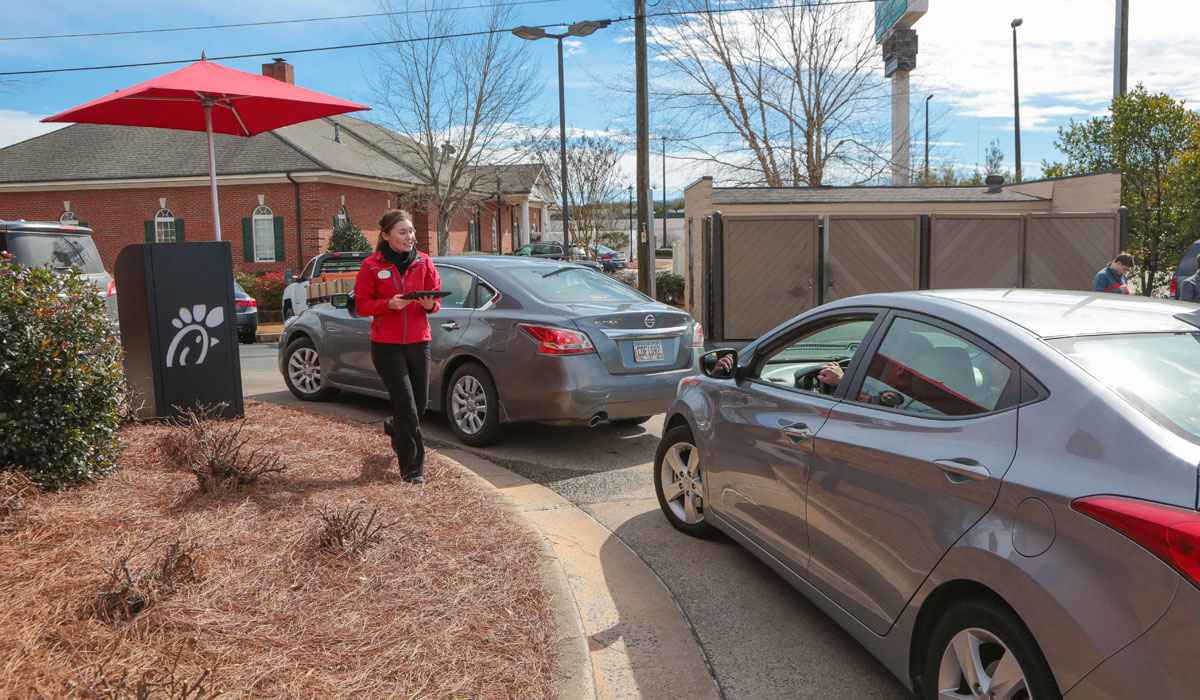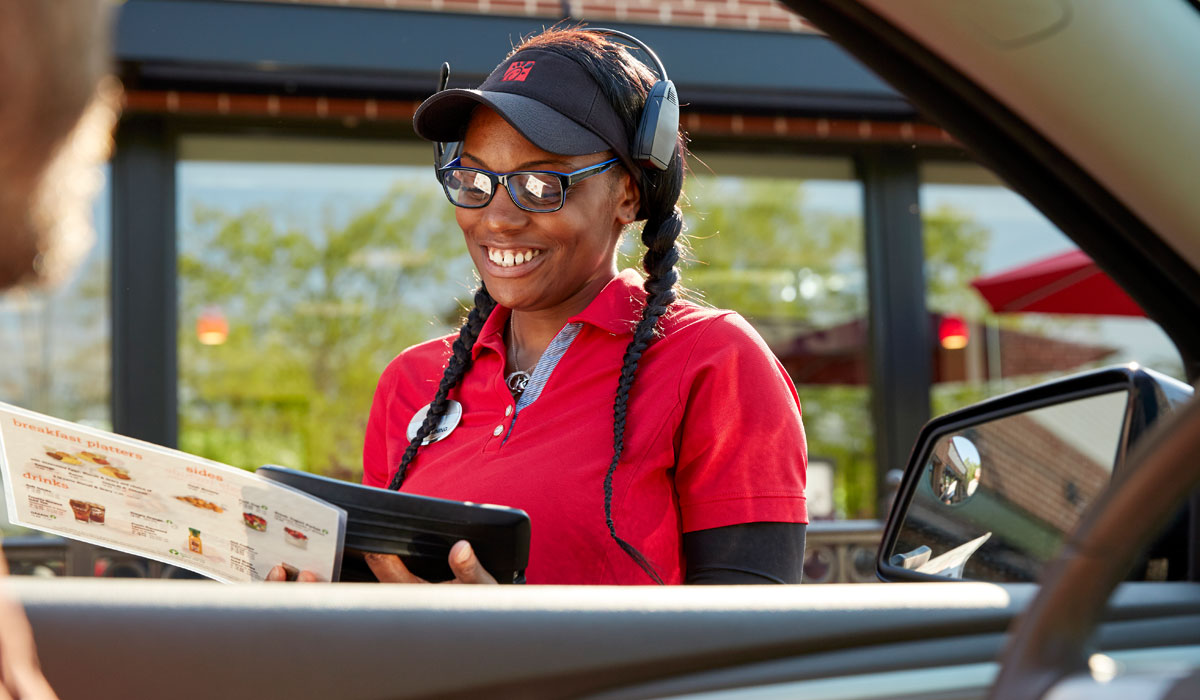When QSR’s Drive-Thru Performance Study, conducted in partnership with mystery shopping firm SeeLevel HX, was released two weeks ago, consumer media pounced on it with more force than anything this magazine has published in its 22 years. Stories from outlets like CNN and Food & Wine rightfully pointed out one of the most startling results of the report: Across the 10 brands studied, the average drive-thru speed of service had slowed by about 21 seconds, from 234.08 seconds in 2018 to 255.34 this year.
But there was one other study result that found its way into many of the consumer headlines—and, it turns out, into the ire of quick-serve customers across the country. Chick-fil-A, we reported, had the longest drive-thru speed of service at 322.98 seconds—more than 1 minute longer than last year. As evidenced by the tsunami of feedback we received on social media, Chick-fil-A fans took umbrage with this result, aghast that the chicken chain might be considered slow. Based on that feedback, one thing became crystal clear: Readers saw “slow” and interpreted that as “bad.”
And that couldn’t be further from the truth.
Chick-fil-A, in many ways, is setting the high bar for quick-service performance, and that’s especially true in drive thru. Between 1998 and 2009, the Drive-Thru Study used a composite score to rank brands; Chick-fil-A claimed the No. 1 spot six times. And in this year’s Drive-Thru Study, Chick-fil-A was best in both order accuracy (at 94 percent, 4 percentage points higher than No. 2 Burger King) and customer service (scoring top marks in eye contact, pleasant demeanor, smiling, saying “please,” and being “very friendly”).
READ MORE: A brand-by-brand drive-thru breakdown
But it’s also important to clarify why Chick-fil-A had the slowest service time, and why it’s more a good thing than bad. Put simply, the company’s speed of service is much longer because its drive-thru lanes are busier than every other competitor—and it’s not even close. A full 77 percent of its drive-thru experiences had three or more cars in line, according to the study, while 35.5 percent had six or more cars in line. For context, McDonald’s claimed the second-busiest drive thru, and only 41.8 percent of its drive thrus had three or more cars and 9.1 percent had six or more.
Even with longer speed of service and incredibly busy drive thrus, 56 percent of Chick-fil-A’s drive-thru experiences were rated as “fast” by mystery shoppers (with 54 percent being the industry average). And the auditors reported that they were “satisfied” or “highly satisfied” by nearly 95 percent of Chick-fil-A’s drive-thru experiences (versus 79 percent industry-wide).
Let’s also unpack the fact that Chick-fil-A’s drive thru is something of a different beast than those of its competitors. Khalilah Cooper, Chick-fil-A’s director of service and hospitality, points out that the brand employs “face-to-face ordering” about 60 percent of the time; in other words, team members are positioned outside to take orders from a tablet, even walking upstream from the speaker box to take orders, “which gives us a chance to greet the guest sooner, when they arrive at the restaurant,” Cooper says. It also allows Chick-fil-A more time to prepare each guest’s order, thereby ensuring quality and accuracy.

Because of the fact that the Drive-Thru Study’s speed of service is measured from the time a customer places an order to the time they receive it, Chick-fil-A’s speed of service inevitably skews long compared with the other brands. (One other way to read Chick-fil-A’s drive-thru speed is through its total time, which measures the drive-thru experience from the time a car pulls into the drive-thru lane to the time it receives food. Chick-fil-A registered a 487-second total time, compared with the industry average of 327 seconds.)
Regardless of the time, Cooper says, what’s important is that Chick-fil-A gets guests in and out as quickly as they can while also creating a top-notch experience.
“We want to create the type of experience that guests trust time and time again,” she says. “If they come to our restaurant, even if they see cars in the line, they know we’ll get them out as quickly as possible, but they’ll also get fresh food and a hospitable experience.”
Chick-fil-A is an outlier in the quick-service industry in so many ways (including with its eye-popping $4 million AUV). With the exception of McDonald’s, no other brand has to get as creative with drive-thru throughput, which has led Chick-fil-A to roll out dual lanes along with the face-to-face ordering crew, who are armed with tablets, mobile card readers, and Bluetooth cash drawers. It’s also installed canopies in the drive thru and employed specially designed crew uniforms to account for inclement weather.
Even its real estate decisions have to be filtered through the fact that its busy drive thrus disrupt the flow of track in and around the lot.
“Having what we call an isolated drive thru is really helpful,” Cooper says. “So instead of having the building in the center of the pad and then the drive thru wrap all the way around the building in a circle, we have the building more off-center on the pad and isolate the drive thru so you only have cars flowing in one direction. Then you don’t have cars in the drive thru also trying to navigate cars that are parked or trying to get out of a parking space.”
“Even just those small moments, regardless of what channels our customers choose to engage with us, can really make the difference in a day.” — Khalilah Cooper, Chick-fil-A’s director of service and hospitality.
And while the brand rather famously eschews order-confirmation boards in the drive thru in favor of human interaction (only 13.1 percent of its locations had OCBs, according to the study, compared with 48.8 percent of the industry as a whole), Chick-fil-A isn’t rejecting technology altogether. It’s not lost on the company that competitors like McDonald’s are heavily investing in new tools like artificial intelligence (AI) and digital, responsive menuboards. Although Chick-fil-A emphasizes the human component of its business, it’s aiming to balance that with the appropriate tech tools.
“Even just the prospect of AI has shifted over the last two years. … As customers’ expectations and needs change and evolve, and their comfort level with certain technology increases, we want to be flexible to be able to meet them where they are and exceed their expectations,” Cooper says. “We do look at bringing that human element out in conjunction with the technology, and not as a replacement.”
Is something wrong with Chick-fil-A’s drive thru, as so much of the feedback we received was accusing us of suggesting? Clearly not. But it’s not to say the broader slowdown across the industry is insignificant.
A few culprits are likely to blame for the industry-wide speed-of-service slowdown. One could be how busy drive thrus are, but it’s hard to say definitively whether the drive thru is getting busier or not. According to a recent off-premises survey from the National Restaurant Association (NRA), 92 percent of consumers report using the drive thru at least once a month, and 39 percent report using the drive thru more often than a year ago.
The Drive Thru Study, though, suggests drive thrus at the 10 surveyed chains may be getting less busy. Six of the 10 chains showed a greater share of their drive-thru experiences having 0–2 cars in line in 2019 over 2018, and a lesser share having 3–5 cars. Just three chains (Burger King, Chick-fil-A, and Dunkin’) reported a lesser share of drive thrus having 0–2 cars and a greater share having 3–5. Taco Bell, meanwhile, enjoyed a greater share of its drive thrus with both 0–2 cars and 3–5 cars (but a drop in the number of its drive thrus with 6-plus cars).
If drive thrus aren’t getting busier, part of the reason might be that the off-premises industry is fracturing, with far more options for consumers to access affordable food. The NRA study showed that 34 percent of consumers are using delivery more often than a year ago, and 29 percent are using takeout more often than a year ago. Third-party delivery services and mobile-order-and-pay solutions are almost certainly making these service alternatives more appealing to time-starved consumers.

So on what can we pin the slower drive-thru times?
The most likely explanation is quick-service menu quality, which has continued to improve in the last decade as competition has gotten stiffer—particularly from the fast-casual side of things—and as consumers have demanded better ingredients and bolder flavors. Higher-quality food takes longer to prepare, which likely explains why a brand like Wendy’s has gone from an average speed of service of 116.2 seconds in 2003 (an all-time study high… er, low) to 230.38 seconds in 2019.
Does any of this matter when viewed through the lens that is Chick-fil-A? Probably not. As Cooper says, it doesn’t matter if the guest is pulling through the drive thru, ordering for delivery, picking up curbside, or dining in the restaurants, the company’s goal is to provide best-in-class performance for every single experience.
“Each of our occasions, we want our customers to think of Chick-fil-A as a place that they can go and they know they’re going to be taken care of, they know it’s going to be fast but that the food will be great, the service will be efficient, and they will have genuine hospitality and a team member who is there to take care of them,” she says. “Even just those small moments, regardless of what channels our customers choose to engage with us, can really make the difference in a day.”









